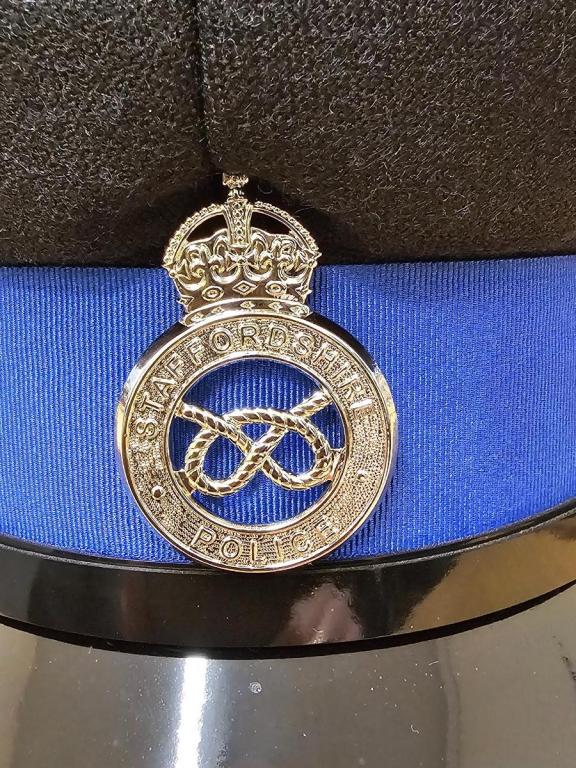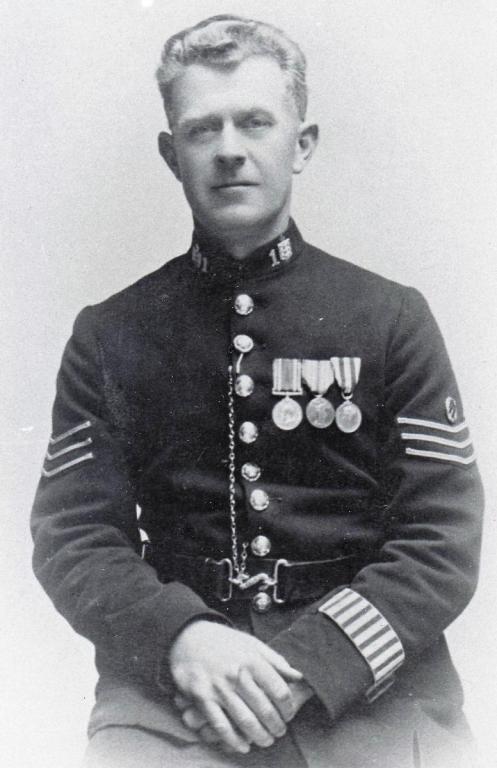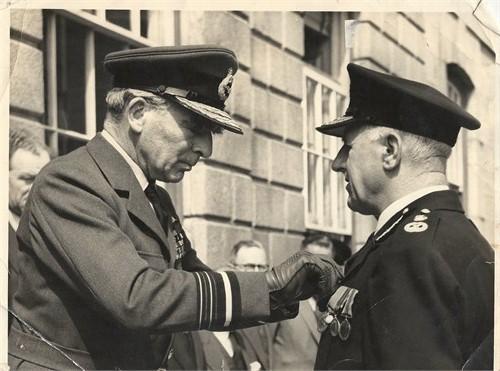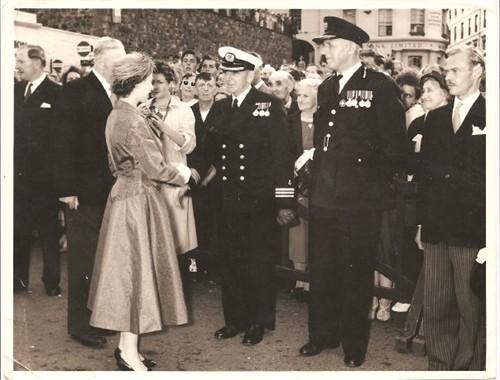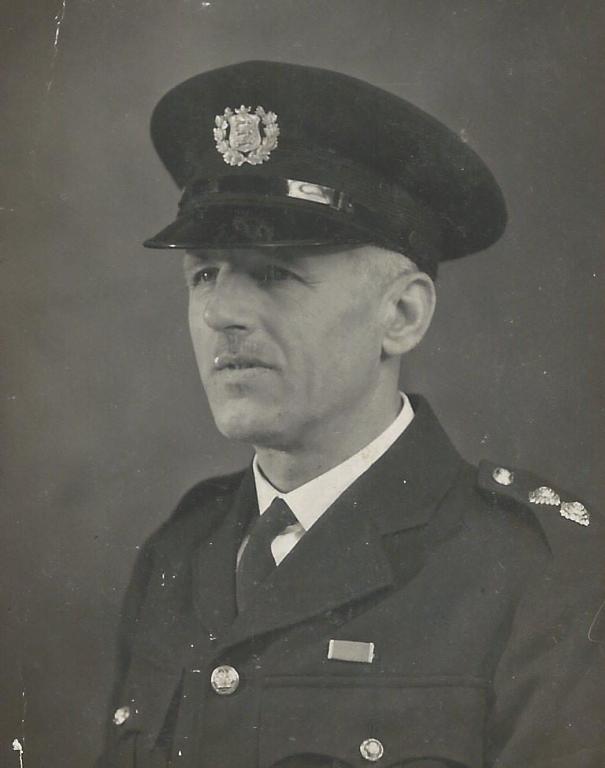
Dave Wilkinson
Active Contributor-
Posts
599 -
Joined
-
Last visited
-
Days Won
7
Content Type
Profiles
Forums
Blogs
Gallery
Events
Store
Everything posted by Dave Wilkinson
-
Tim, When you reply to a topic, or start a new post, at the bottom of the box you are typing in, you will see the image of a paperclip on the left hand side. I click on the blue highlighted words "choose files". That should take you to images stored on your computer. Select your image. Click on "open" and the image will appear on the bottom of your posting. I did have a spare copy of "Badges of Office", but unfortunately parted with it. The book is out of print and has been for several years. Despite that fact, I would not pay any more than £20-25 for a copy for it if you do find one. Dave.
-
Tim, There was indeed a Torquay Police Force. It existed between 1835 and 1857. There were never any helmet badges but there were tunic buttons. I have an example in my collection. See appended photo. Devon & Cornwall had a myriad of small Town Police Forces, most of which existed for only a few years. Dave.
-
I would not recommend buying this. There is a degree of misinformation contained within it and some incorrectly described illustrations which are in the main copied from various sources. The individual in question invariably marks each of the photos with his "copyright" mark. Rather rich, when you consider that the majority of the images are taken from eBay and other uncredited sources. A far more reliable tome is that published by the Police History Society, and which is mentioned in my previous posting. I have no time for individuals who seek financial or other such advantage using images belonging to others, without appropriate credit or permission.
-
I've collected British police insignia since 1966, and have had an interest in the history of British policing since that time. I've looked at several publications. Two in particular "Survey of the Present and Former Police Forces of England, Wales & the Channel Islands" By H.V.D. Hallett (July 1975), and "The British Police, Police Forces & Chief Officers 1829 -2012. Published by the Police History Society (2nd Edition 2011). Neither mention the Stonehouse Borough Police. There is a third book, "Badges of Office" by Wilkinson & Taylor. This book gives details of a "family tree" for each of the current forces. Again, no mention. I don't know who has provided you with the information you apparently have, but it is manifestly wrong. No such force has ever existed. As an aside, I'm sorry to say that I've not been able to open your attachment. So, as I've said previously, you are looking for a helmet plate that does not exist. Dave.
-
There was never, according to the records I have, such a police force. If they did have a body of police or Constables then they existed before the creation of recognised police forces. That being the case, they would not have worn helmets, which came into use circa. 1865. Dave. Ps. I assume you are talking about Stonehouse in Devon. If you are, it was never a "Borough" but was an area of what is now part of Plymouth.
-
Without wishing to "stir" the proverbial, I do think that the continual churning out of medals by the UK Government seems to be spiralling out of control. We will soon bring ourselves into line with those other nations (I won't name them) whose uniformed representatives adorn themselves with what seems to be endless lines of medal ribbons. Some of those individuals are obviously very young in service and yet have two or more lines of ribbon to their credit already. What are they for I ask myself, completing their recruit course successfully, or perhaps good attendance for six months? Before my retirement, I spent 20 plus years working in a law enforcement capacity at the Port of Dover and had almost continuous involvement with HM Immigration Service and its later re-incarnation. So, there is little I do not know about their work. Its gone from a non-uniformed, non-confrontational role to a rather aggressive arm of the Home Office. They went from wearing a smart civilian lounge suit to adopting a uniform which so emulates that of a bobby complete with batons and handcuffs hanging from their belt, that they are often wrongly described by many as "police", a term which they themselves seem to cherish. The term "Border Force" appears to be out of step with the Government's wish to be "Service" oriented. The police have (in the main) long since ceased to use the term "police force", so I wonder why there is this desire to present an image which is so out of keeping with what people expect. Do they embark upon dangerous assignments? Probably. But I know from my own experience that they go about their enforcement work "mob handed" and seldom if ever operate on their own. So the risk of them being injured or attacked is reduced significantly. The same could also have been said for the old HM Customs & Excise. If they were dealing with the public there were invariably five or six of their staff present. One further comment I would make is that they are supported by a very active Union and have the right to withdraw their labour at the drop of a hat. Not that the general public would give a hoot if that were to take place, as indeed it has in the past, with very little effect. So, they've got themselves a Long Service & Good Conduct medal. They've joined the "club". Well done! Personally, I've always thought that the elderly gentleman who operates the School Crossing Patrol near where I live has a particularly dangerous job. He's on his own and often faces anger, aggression and risk of assault most days. I'm tempted to start an on line petition suggesting that after two years continuous service he should get a medal. Now that's a thought! Dave.
-
Police badge identification required
Dave Wilkinson replied to Grandad1933's topic in Police Forces of the World
It is an epaulette badge worn by the States of Jersey Police. Dave. -
-
He's clearly not an unintelligent man otherwise he would not hold the position of Chief Constable. As such, he would surely have known quite well what the protocols are in respect of the wearing of medals. If he wasn't (which I doubt), then there are people around him who would surely have told him. Prior to being appointed CC of Northamptonshire, he was with Greater Manchester Police. in fact he was the divisional commander of the two policewomen, Nicola Hughes & Fiona Bone who were murdered there several years ago. As to when he began wearing medals to which he is not entitled, I don't know. He also attracted publicity recently by saying that he would pay personally for a supply of union flag "thin blue line" patches for his force to wear on their uniforms, saying that it was important to remember the sacrifice of police officers who loose their lives when performing their duty. His decision making ability appears to be seriously flawed, which having regard to the position he holds, must be very worrying for those who rely upon him to make such decisions. If you look back over the past few years its amazing how many Chiefs', Deputies', and Assistants' that find themselves the subject of disciplinary investigations, many of which result in premature retirement or other methods of disposal, resulting in their departure. There must be something seriously wrong with the way these individuals are selected for these positions. Many of the old style Chiefs' will be spinning in their graves. Dave.
- 1 reply
-
1
-
DPK, Its interesting to see that the medals to which you refer are "created" by individual Australian police forces as opposed to being a "national" award approved by Parliament. That suggests that (two or three?) individual forces have found the need to "fill the gap" for want of better words. If that were to happen here in the UK, and I don't think that legally there is anything to prevent it, then such medals would be regarded as "unapproved" and would need to be worn on the opposite side of the chest to awards approved by the Sovereign by Royal Warrant under his Sign Manual. The creation of such awards and monetary allowances' here by individual forces would be akin to the merit and commend badges which some UK forces issue. Nothing more and nothing less. I think it unlikely that (unlike Australia) UK forces would go it alone. If such a thing were to come to fruition here nationally, and it was not far reaching in terms of eligibility, there would quickly be a petition created to award medals posthumously to every police officer killed on duty (or pensionably injured) since the beginning of the last century. Where is the line to be drawn? In my opinion the whole concept of medals being issued (for whatever reason) appears to be getting out of hand. Everybody wants one, in some cases whether they are entitled to it or not! If care is not taken many will become nothing but questionable/meaningless trinkets Dave.
-
Yes, it is. You can see it more clearly if you zoom in on this medals on the photo of him getting his QPM. Dave. The one on the extreme left (Lamy) with the black ribbon is Order of St. John. Can't make out what "C" is. I'm also stumped with your query re. Le Lievre's unidentified medal. Could be one of the war medals as you suggest. Dave.
-
I have a large file of papers and photos relating to Insp. Lamy and Guernsey Police generally. I'm attaching a photo of Sgt. Chas. Le Lievre wearing his medals including KPM. His medals are in the possession of his family who are still resident on Guernsey. Another photo shows Mr. Lamy being presented with his QPM by the Governor of Guernsey and finally one showing him during a visit to Guernsey by HM The Queen . As you can see he does indeed have the LSGC medal. Dave.
-
The Chief Officer of the Guernsey Island Police during the German Occupation was Inspector Albert Lamy. He was awarded the BEM, in the "Occupation Honours" post liberation and the appended photo shows him wearing the appropriate ribbon. As you correctly say, the "Defence Medal" was not awarded to anyone remaining on any of the Islands during WWII. The reason for this is presumably because the Islands were not defended as such, by anyone remaining there. The armed forces of the Crown were withdrawn and they were all left to their fate. With regard to the Police LSGC medal, this was awarded to the Jersey and Guernsey Police when it was introduced in 1951. Interestingly, service during the German occupation counted as "approved service" for the purpose of the award of the medal. Dave.
-
The "cloth" part of the belt was hidden from view beneath the tunic. The leather straps were allowed to protrude from the "slit" in the tunic waist and hang down. It is not a cross belt. The sword could be carried on either side of the tunic. It was the wearers preference, his tunic being tailored accordingly. Looking at the weapon, I'd suggest that it is not intended to to go with the tunic or belt and is probably a "marriage" having been added to the ensemble at some point. Dave.
-
Breast badges
Dave Wilkinson replied to I_♥_Police's topic in Great Britain: Mervyn Mitton's British & Colonial Police Forces
Very interesting. Excellent detective work locating the image, which is entirely new to me. For some inexplicable reason, the Metpol. Inspector on the extreme right is wearing on his breast the cap badge of the short lived Devon & Exeter Police (1966-1967). I'm attaching a photo of the small group of badges which were produced for that force. The collar badges were issued and worn. However, the cap badge was only worn by Special Constables and the numbered breast badge was not worn at all. To confuse matters further, the Coat of Arms is that of Devon County Council with no Exeter connection whatsoever. I suspect that the Met. have used "sample" badges (not related to the Met.) simply to display the proposed uniforms. I've not been able to identify the badges being worn on the breast of the other two bobbies. However, the one being worn by the guy in the centre seems to be the collar badge of the Durham Constabulary, with a small number section fixed below it. Dave. -
The Island of Jersey is a self governing British Crown Dependency. It is not technically a part of the United Kingdom, but is part of the British Isles. The King is represented on the island by a Lieutenant Governor. The States of Jersey Police has its origins dating back to 1853, when a small group of uniformed men were appointed to police the Parish and town of St. Helier. They were known as the "St. Helier Paid Police". The policing of the remainder of the island was the responsibility of the Honorary Parish Police in each of the remaining eleven parishes. The uniformed police remained under the control of the Parish of St. Helier until 1952. At that time they were transferred to the control of the Island's Government, the States of Jersey. The strength at that time was 64 men and the title of the force was changed to "States of Jersey Police". That said, their activities were still centred upon St. Helier although they did venture out of the town when requested by the outer Parishes'. They later performed regular mobile patrols throughout the island, but had to inform the relevant Parish Constable of any incidents that they came upon or were called to attend. They now provide a policing service to the whole island. However, the relevant Parish Honorary Police still have primacy in respect of the decision to charge offenders. The Parish Centenier is the only person (other than the Attorney General) who has the power to charge an offence and it is he/she who presents the case at the Magistrates' Court. The current strength of the States of Jersey Police is 214 officers plus 121 civilian staff. Below is a representation of the badges worn since their formation. Dave.
-
The badge on the top left is the second issue cap badge and the one on the left is the current issue cap badge. I'm unsure as to whether they use a warrant badge. I understand that caps are now seldom worn and day to day they wear a baseball type hat. The two rectangular patches are the first generation patch versions and the bell shaped one is the later type, all three were/are worn on "NATO" type pullovers and outer coats. Dave. Thank you for your continued interest. Dave.


.thumb.jpg.54751c75caf272f1f36ba8ef8e272f8b.jpg)
